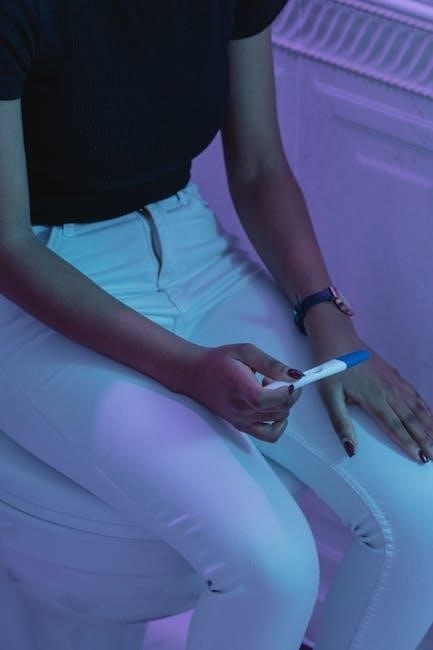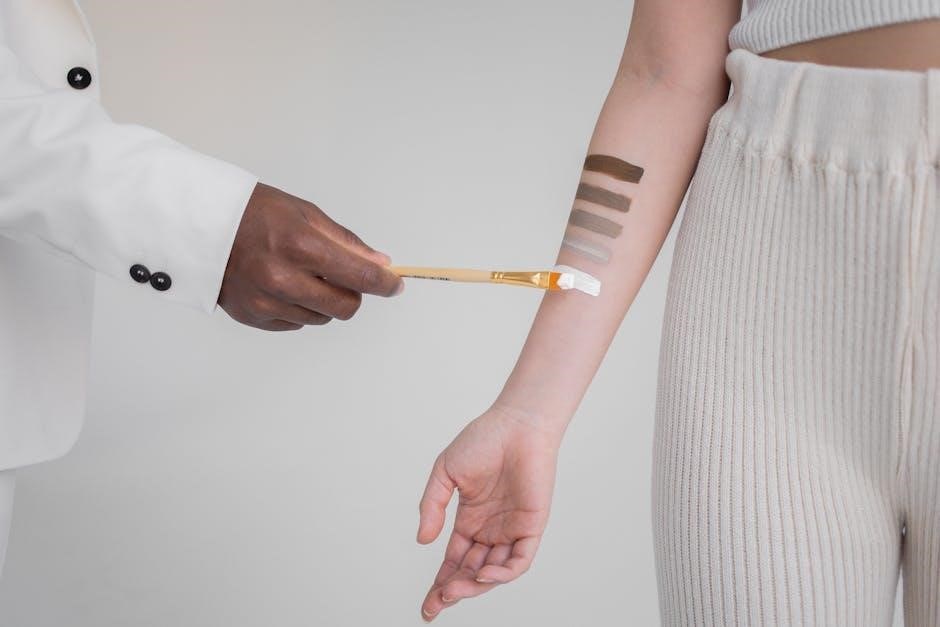Reality testing involves distinguishing internal thoughts from external reality, crucial for assessing delusional beliefs. Delusions are fixed, false beliefs disconnected from evidence, impacting perception and behavior significantly.
1.1 Understanding Reality Testing in Mental Health
Reality testing is a critical concept in mental health, referring to the ability to distinguish between internal thoughts and external reality. It is a cornerstone in assessing delusions, as it helps clinicians understand how individuals perceive their environment. Originating from psychoanalytic theory, reality testing evaluates whether a person can differentiate between fantasies and actual events. In mental health assessments, it is used to identify distortions in perception, such as delusional beliefs, and guide therapeutic interventions. Accurate reality testing is essential for diagnosing conditions like schizophrenia and managing delusional disorders effectively.
1.2 Defining Delusions and Their Impact on Reality Perception
Delusions are fixed, false beliefs that persist despite evidence to the contrary, significantly altering reality perception. They are a hallmark of psychotic disorders, such as schizophrenia and delusional disorder. Delusions distort an individual’s ability to interpret events, leading to misinterpretations of their environment. This distortion can severely impact daily functioning, relationships, and overall mental health. Understanding delusions is crucial for developing effective reality testing strategies to help individuals regain a clearer grasp of reality and improve their quality of life;

The Role of Reality Testing in Assessing Delusions
Reality testing evaluates the severity and nature of delusions, helping differentiate between distorted beliefs and actual events. It is essential for understanding delusional intensity and guiding treatment plans.
2.1 Clinical Applications of Reality Testing
Reality testing is a fundamental tool in clinical settings for assessing delusions. It helps clinicians evaluate the severity of delusional beliefs, identify distortions in thought patterns, and differentiate between delusional thinking and reality-based perceptions. By using specific questions and techniques, healthcare providers can gain insights into a patient’s mental state, guiding diagnostic processes and treatment strategies; This approach is particularly valuable in psychosis, schizophrenia, and delusional disorders, enabling tailored interventions to improve patient outcomes and quality of life.
2.2 Differentiating Between Delusional Thinking and Reality
Delusional thinking involves fixed, false beliefs resistant to evidence, whereas reality-based thinking is flexible and aligned with external evidence. Delusions often contradict cultural norms and are unresponsive to counterarguments. Clinicians use reality testing to assess whether beliefs are grounded in reality or distorted by delusional thought patterns. This differentiation is critical for accurate diagnoses and effective treatment planning in mental health conditions like schizophrenia and delusional disorders.

Common Reality Testing Questions for Delusions
Common questions include open-ended inquiries about beliefs and specific probes to assess conviction levels. These questions help clinicians evaluate the fixed nature of delusions and their impact on daily life.
3.1 Open-Ended Questions to Elicit Delusional Content
Open-ended questions are designed to explore delusional beliefs without confrontation. Examples include, “Can you describe your thoughts about [specific belief]?” or “How do you think this situation affects your life?” These questions encourage individuals to share their perceptions freely, allowing clinicians to understand the nature and intensity of delusions. They are essential for gathering detailed information about the content, conviction, and impact of delusional thoughts on daily functioning and reality testing abilities.
3.2 Yes/No Questions to Assess Reality Testing
Yes/No questions help evaluate the fixed nature of delusions and reality testing. For example, “Do you believe your thoughts are true despite contradictory evidence?” or “Is there any possibility your belief might not be based on reality?” These structured questions provide clarity on the individual’s conviction and insight, aiding in differential diagnosis and treatment planning. They are particularly useful in clinical settings to gauge the rigidity of delusional beliefs and assess the effectiveness of therapeutic interventions.
3.3 Questions to Evaluate the Fixed Nature of Delusions
Questions to assess the fixed nature of delusions focus on the individual’s conviction and openness to alternative explanations. Examples include, “How certain are you that your belief is true?” or “Could there be any evidence that might change your belief?” These probes help determine the rigidity of delusional thinking and its resistance to contradictory information. Such inquiries are essential in therapy to understand the depth of delusional beliefs and guide appropriate interventions for reality testing and cognitive restructuring.
Cognitive-Behavioral Techniques for Reality Testing
Cognitive-behavioral techniques, like restructuring and behavioral experiments, help individuals challenge delusional beliefs by examining evidence and testing reality-based alternatives, fostering more flexible thinking patterns.
4.1 Cognitive Restructuring for Delusional Beliefs
Cognitive restructuring is a key technique in addressing delusional beliefs by identifying and challenging distorted or unhelpful thought patterns. This process involves examining evidence for and against delusional ideas, fostering a more balanced and reality-based perspective. By encouraging individuals to question their fixed beliefs, cognitive restructuring aims to reduce the intensity and impact of delusions on daily functioning and mental health outcomes.
Through guided reflection and evidence evaluation, individuals learn to differentiate between delusional thoughts and objective reality, promoting more flexible thinking and reducing distress associated with delusional beliefs.
4.2 Behavioral Experiments to Challenge Delusions
Behavioral experiments are practical tools used to test the validity of delusional beliefs. These experiments involve creating real-world scenarios to observe outcomes that may contradict delusional thoughts. For example, if a person believes they are being followed, a structured observation of their surroundings can provide evidence to the contrary. This approach helps individuals gather concrete information, reducing the intensity of delusional beliefs and fostering a more realistic understanding of their environment.
By engaging in these activities, individuals can develop skills to critically evaluate their perceptions and improve their ability to distinguish between delusional ideas and actual events.

Assessing the Severity of Delusions
Assessing delusion severity involves using standardized rating scales to measure intensity and impact on daily life, while evaluating insight and reality testing abilities.
5.1 Rating Scales for Delusional Intensity
Rating scales like the Psychotic Symptom Rating Scales (PSYRATS) and the Scale for the Assessment of Positive Symptoms (SAPS) are commonly used to measure delusional intensity. These tools assess factors such as conviction, preoccupation, and impact on behavior. Clinicians use these scales to quantify the severity of delusions, aiding in diagnosis and treatment planning. By standardizing assessment, these scales ensure consistency and reliability in evaluating delusional intensity across different clinical settings.
5.2 Measuring Insight and Reality Testing Abilities
Insight and reality testing abilities are assessed using standardized tools like the Insight Scale and the Beck Cognitive Insight Scale. These tools evaluate a person’s awareness of their delusions and their ability to distinguish between internal beliefs and external reality. Higher insight levels correlate with better treatment outcomes, as individuals are more likely to engage in therapy. Clinicians use these measures to track progress and tailor interventions, focusing on enhancing self-awareness and improving reality testing skills in individuals with delusional disorders.
Special Considerations in Reality Testing
Cultural sensitivity and ethical awareness are crucial when assessing delusions. Understanding cultural influences on belief systems and differentiating delusions from other thought disorders ensures accurate evaluation and respectful care.
6.1 Cultural Factors Influencing Delusional Beliefs
Cultural background significantly shapes delusional content and interpretation. Beliefs considered delusional in one culture may align with another’s norms or religious practices. For example, hearing voices from ancestors is culturally accepted in some societies, while in others, it may indicate psychosis. Clinicians must consider these factors to avoid misdiagnosis and ensure culturally sensitive assessment. Understanding cultural nuances enhances accurate reality testing and therapeutic rapport with individuals from diverse backgrounds.
6.2 Differentiating Delusions from Other Thought Disorders
Delusions are distinct from other thought disorders like obsessions or hallucinations. Delusions are fixed, false beliefs, whereas obsessions are recognized as irrational. Hallucinations involve sensory experiences, not beliefs. To differentiate, clinicians assess the content, conviction, and behavioral impact. Delusions are unshakable and disconnected from reality, while other disorders may show flexibility or insight. Accurate differentiation is crucial for diagnosis and treatment, ensuring appropriate interventions for conditions like schizophrenia or delusional disorder.
The Role of Caregivers in Reality Testing
Caregivers play a vital role in supporting individuals with delusional disorders by fostering a non-confrontational environment, encouraging reality-based interactions, and helping them improve daily functioning and insight into their beliefs.
7.1 Supporting Individuals with Delusional Disorder
Supporting individuals with delusional disorder requires empathy and patience. Caregivers should avoid confrontation and instead encourage open dialogue. They can help by fostering a non-judgmental environment, promoting reality-based thinking through gentle questioning, and assisting with daily tasks; Encouraging journaling to track delusional thoughts can also aid therapy. Caregivers should focus on setting achievable goals, celebrating progress, and maintaining routine to provide stability. Professional guidance and therapy should always be involved to ensure effective support and intervention.
7.2 Communication Strategies for Caregivers
Effective communication with individuals experiencing delusions requires empathy and clarity. Caregivers should use open-ended questions to explore thoughts without judgment. Active listening and validation of feelings, rather than the delusional content, can build trust. Avoid arguing or confronting delusions directly, as this may escalate resistance. Instead, gently provide reality-based feedback and encourage reflection. Consistent, patient communication helps individuals gradually question their beliefs and strengthens therapeutic relationships. Reassurance and support are key in fostering a collaborative environment for understanding and growth.
Self-Testing Reality Testing Questions
Self-testing questions help individuals assess their thoughts and distinguish between delusional beliefs and reality. These tools promote self-awareness and critical thinking about one’s perceptions and beliefs;
8.1 Self-Assessment Tools for Delusional Thoughts
Self-assessment tools, such as questionnaires and checklists, enable individuals to evaluate their thoughts and beliefs critically. These tools include structured questions like, “Do you believe others are plotting against you?” or “Do you think your thoughts are being controlled?” They help identify delusional content and assess the intensity of beliefs. Examples include the Peters Delusions Inventory (PDI), which measures the conviction and preoccupation associated with delusional ideas. These tools promote self-awareness and can guide individuals to seek professional help when needed.
8.2 DIY Techniques for Improving Reality Testing
Individuals can practice DIY techniques to enhance reality testing, such as grounding exercises like focusing on sensory details or journaling to track thoughts. Checking evidence for beliefs and seeking feedback from trusted others can also help. Mindfulness practices improve awareness of thought patterns, while cognitive exercises challenge rigid beliefs. These methods encourage critical thinking and gradual improvement in distinguishing delusional thoughts from reality, fostering mental clarity and better emotional regulation.
Limitations and Challenges in Reality Testing
Reality testing faces challenges like resistance from individuals with delusional disorders and ethical concerns in assessment. These limitations highlight the complexity of accurately evaluating and addressing delusions.
9.1 Resistance to Reality Testing in Delusional Disorders
Individuals with delusional disorders often exhibit strong resistance to reality testing due to the fixed nature of their beliefs. This resistance stems from the delusions being deeply ingrained, making it challenging for them to accept contradictory evidence. Such resistance can hinder therapeutic progress, as the person may perceive reality testing as a threat to their belief system. Clinicians must approach these cases with empathy and patience, employing strategies that gradually encourage self-reflection without confrontation.
9.2 Ethical Considerations in Assessing Delusions
Ethical considerations in assessing delusions involve ensuring informed consent, respecting patient autonomy, and maintaining confidentiality. Clinicians must avoid coercive practices and be culturally sensitive, recognizing that delusional beliefs may vary across backgrounds. Additionally, ethical dilemmas arise when balancing the need for accurate assessment with the potential distress of challenging deeply held beliefs. A non-judgmental and empathetic approach is essential to build trust and respect the individual’s perspective, even when their beliefs are not grounded in reality.

Case Studies and Real-World Applications
Case studies demonstrate how reality testing questions effectively assess delusions in clinical settings, providing insights into their application and therapeutic benefits for patients with psychotic disorders.
10.1 Successful Outcomes of Reality Testing in Therapy
Reality testing has shown significant success in therapy by helping individuals with delusions gradually align their beliefs with reality. Through structured questions, patients develop critical thinking, reducing the intensity of delusional thoughts. This approach fosters insight and improves daily functioning, enabling better coping mechanisms and enhancing overall mental health outcomes. Successful cases highlight the importance of consistent, non-confrontational techniques in promoting long-term recovery and reducing symptom severity in delusional disorders.
10.2 Challenges in Applying Reality Testing in Clinical Settings
Applying reality testing in clinical settings presents challenges, such as patient resistance to questioning delusional beliefs. Delusions are deeply ingrained, making it difficult for individuals to accept alternative perspectives. Additionally, ethical concerns arise regarding how to approach sensitive topics without causing distress. Clinicians must balance empathy with effectiveness, ensuring interventions are non-confrontational and culturally sensitive. The complexity of delusional content and varying patient insight further complicate the process, requiring tailored approaches and ongoing training for mental health professionals.
Reality testing is crucial for assessing delusions, aiding in differentiation between internal beliefs and external reality. Future research should focus on enhancing cognitive-behavioral techniques and improving diagnostic tools.
11.1 Summary of Key Findings
Reality testing is a critical tool for assessing delusions, enabling differentiation between internal beliefs and external reality. Delusions are fixed, false beliefs resistant to evidence, significantly impacting perception and behavior. Cognitive-behavioral techniques, such as cognitive restructuring and behavioral experiments, have shown efficacy in addressing delusional thoughts. Cultural factors and caregiver support play pivotal roles in managing delusional disorders. Future research should focus on enhancing diagnostic accuracy and developing personalized interventions to improve reality testing abilities and overall mental health outcomes for individuals with delusional disorders.
11.2 Advances in Reality Testing for Delusions
Recent advancements in reality testing include the integration of digital tools and personalized cognitive-behavioral approaches; Mobile apps now offer real-time monitoring and guided exercises to challenge delusional thoughts. Research into neural mechanisms underlying delusions has improved therapeutic precision. Additionally, culturally sensitive assessment methods ensure more accurate diagnosis. These innovations enhance early intervention and tailored treatment plans, fostering better outcomes for individuals with delusional disorders and improving their ability to distinguish reality from delusional beliefs effectively.

References and Resources
- Cognitive-Behavioral Therapy for Delusions by X. Amador, 2021.
- Reality Testing in Psychotic Disorders, Journal of Mental Health, 2023.
- RealityTestingGuide.pdf – A comprehensive guide for clinicians.
12.1 Recommended Reading on Delusions and Reality Testing
Key resources include Cognitive-Behavioral Therapy for Delusions by X. Amador, offering practical techniques for addressing delusional beliefs. Reality Testing in Psychotic Disorders provides clinical insights into assessment methods. Additionally, RealityTestingGuide.pdf is a comprehensive tool for clinicians, featuring structured questions and evaluation frameworks. These materials are essential for understanding and implementing effective reality testing strategies in both therapeutic and diagnostic settings.
12.2 Online Tools and PDF Guides for Reality Testing
Several online resources provide structured approaches for assessing delusions. Tools like RealityTestingGuide.pdf and DelusionAssessmentToolkit.pdf offer comprehensive frameworks for evaluating reality testing. Websites such as delusiontesting.org and realitytestingtools.net feature downloadable guides with specific questions and techniques. These resources are invaluable for clinicians and researchers, offering practical methods to identify and address delusional thinking effectively. They also serve as educational materials for caregivers seeking to understand and support individuals with delusional disorders.



